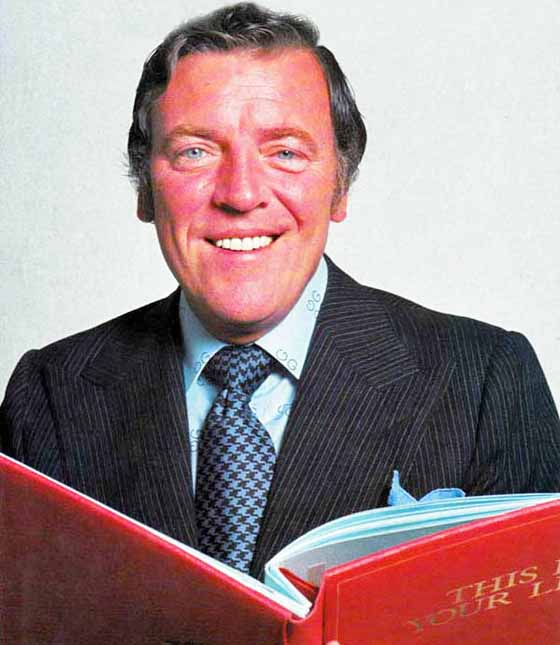Big Red Book
Celebrating television's This Is Your Life
Eamonn Andrews (1922-1987)
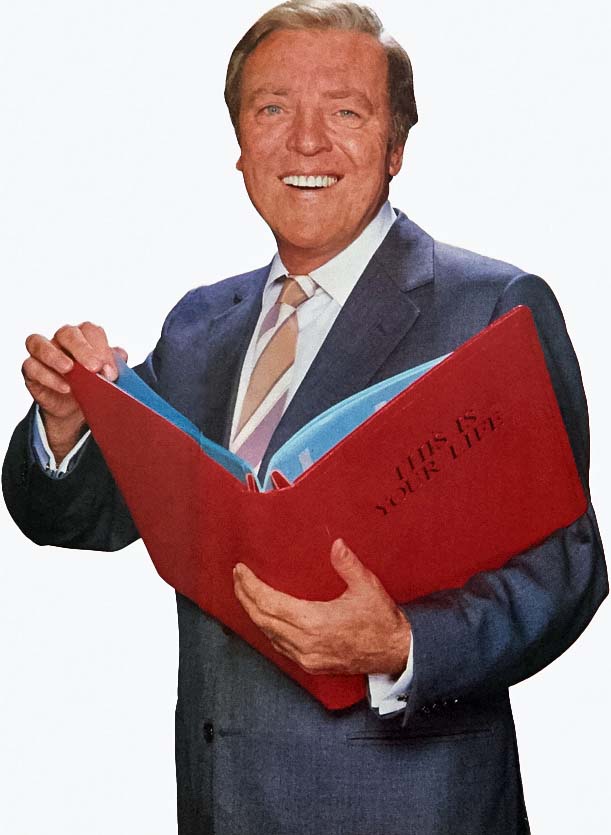
"After my first viewing of This Is Your Life, I said to myself, 'This is television'"
The first time Eamonn Andrews saw the television programme This Is Your Life was in America in 1955.
The programme launched on US television in October 1952 and had become required viewing for the American public.
While in the US on a sports assignment for the BBC, Eamonn watched an edition of the programme - and the consequences of doing so would have a significant and lasting effect on his career...
This Is Your Life
Subject:
The very first UK edition hosted by Ralph Edwards
Surprised again - this time by magician David Nixon
Host:
735 editions 1955-64 / 1969-1987
related pages...
Eamonn's first appearance as a subject of This Is Your Life
Eamonn's second appearance as a subject of This Is Your Life
tributes to the original presenter
The Legend That Was Eamonn Andrews
a celebration to mark the presenter's centenary year
the producers who steered the programme's success
the show's fifty year history
the genesis of the programme
the man who created it all
the programme's relaunch
those who said 'No'
first-hand recollections
A seven-part article on Eamonn Andrews from John Bull Magazine
What A Surprise For Eamonn Andrews
Press reviews of the programme's first edition
The BBC Personality of the Year
The Daily Mirror profiles Eamonn Andrews
TV Mirror reports on the presenter's popularity
Eamonn Andrews - Answers the Question that Everyone Asks Him!
Eamonn Andrews defends his high-profile
Award Winners 1960: This Is Your Life
Eamonn Andrews receives an award nomination
Radio Times profiles Eamonn Andrews
TV Times article on Eamonn Andrews
Eamonn Andrews previews the programme's relaunch
Somewhere, Someone - This Is Your Life
Talk of Thames feature on the programme's 1969 relaunch
TV Times article on Eamonn Andrews
Eamonn faces up to his question time
TV Times article on the family life of Eamonn Andrews
Eamonn Andrews: This Is Your Other Life...
TV Times article on Eamonn Andrews
Roger Elliot Predicts For Eamonn Andrews
The TV Times astrologer predicts the year ahead for Eamonn Andrews
Some people can't cope with being a superstar...
A frank interview with Eamonn Andrews
TV Times feature on Eamonn Andrews
TV Times interviews Eamonn Andrews
Mrs Andrews' line is tops with the brides
TV Times feature on Eamonn's wife, Grainne
Press coverage of the death and memorial service of Eamonn Andrews
RTE Guide tribute to Eamonn Andrews
Andrews's death casts doubt on his show
The Guardian reports the death of Eamonn Andrews
The Sun's coverage of the death of Eamonn Andrews
The children of Eamonn Andrews remember him in a feature for Woman's Own
Eamonn Andrews by Tom Brennand
Press reviews of the former scriptwriter's new book
How Eamonn carved a life from insecure beginnings
The Stage reviews the book For Ever and Ever, Eamonn
The Sunday Times feature on Eamonn Andrews
Maurice Leonard recalls Eamonn Andrews
Press coverage of a new documentary on Eamonn Andrews
TV star Eamonn Andrews loved Portmarnock home
Irish Independent feature on Eamonn Andrews
Press obituaries for This Is Your Life scriptwriter
An Irish Post feature on Eamonn Andrews
Eamonn Andrews, who was born in Dublin on 19 December 1922, was educated at the city's Synge Street Christian Brothers' School, only a short distance from the family home he shared with his parents, three sisters and a brother.
It was at school that Eamonn developed a passion for sport, in particular, boxing. He joined St Andrews boxing club in Dublin and became a successful amateur boxer, winning the All-Ireland Juvenile title.
His other passions were literature and theatre. He was interested in amateur dramatics and, along with friends, established a drama group called Blue White Productions, named for their old school colours. In addition to acting, he was a keen writer and tried his hand at writing plays and poetry.
"Convinced I had the talent to earn money from writing, I spent more and more time knocking out short stories and articles. And whenever I read of a competition that had a literary flavour, I would hide myself away in the parlour and write furiously to try to win a prize."
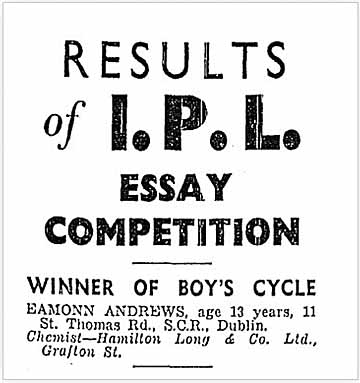
Eamonn won a bicycle in an essay writing competition at the age of 13, as announced in this cutting from the Irish Press newspaper in May 1936
Boxing took up much of his time outside school, and ironically his first payment for writing was connected to his favourite sport:
"It happened after I won an All-Ireland Juvenile title. Convinced that all I had to do now was sit and wait as sports editors clamoured for my signature, I toiled over the typewriter and got out a piece on How to Train For a Fight. Straight to the sports editor of the Evening Herald, I sent it, and to my astonishment, he accepted it, published it, gave me a by-line, and sent me a guinea."
By age 16, Eamonn was already keen to expand his ambition from writing to broadcasting. Having claimed to be an expert on boxing, he applied for work with Radio Eireann - Dublin's commercial radio station – and following an audition, he was offered a try-out:
"...somebody... wrote to me and told me they were going to give me a try-out on a real broadcast. This was it. This was the key to Radio. This was the most exciting, heart-stopping letter I had ever received."
The try-out was a success, and Eamonn began his broadcasting career, providing regular commentaries for such sports as boxing, rugby and soccer.
Meanwhile, his interest in theatre continued to grow, and as well as enrolling on an acting course with Ria Mooney at the Abbey Theatre, he also took part in plays on Radio Eireann and even had his own play produced at the Peacock Theatre - a solemn and unsuccessful work entitled The Moon is Black.
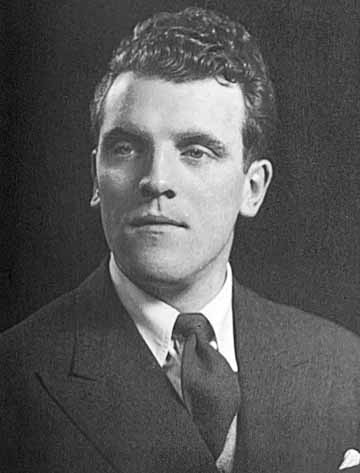
As a teenager, Eamonn had various interests to keep him busy, including boxing and literature
After leaving school, he found regular work at the Hibernian Insurance Company in Dublin as a junior clerk earning £1 a week. However, this was boosted by the income from his broadcasting commentaries for Radio Eireann and from selling boxing articles to local newspapers.
And he was still boxing - at the age of 22 in 1944 at the National Stadium in Dublin, Eamonn entered the Irish Junior middleweight title – and won. But not before he had commentated on the other semi-final!
By 1946, with his writing and broadcasting endeavours bringing in more money, Eamonn decided to leave the security of his regular wage from the Hibernian and become a full-time writer and broadcaster.
Eamonn now had time to work on other radio programmes, one of which, Microphone Parade, ran for almost three years without a break and involved him interviewing visiting celebrities.
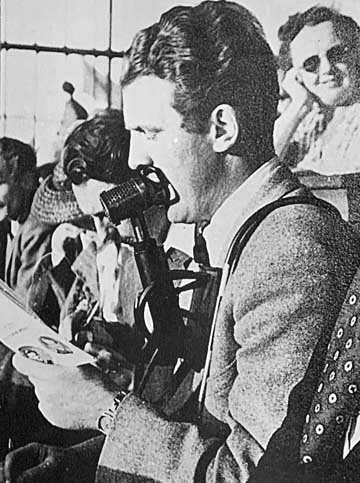
Eamonn became a full-time writer and broadcaster after leaving the Hibernian Insurance company, where he had worked as a clerk
Around this time in Ireland, a new entertainment phenomenon emerged known as Cine Variety, whereby cinema owners offered live entertainment before showing a film in return for a tax break.
Eamonn was offered the chance to present a quiz called Double or Nothing, where audience members would attempt to answer questions for cash prizes.
After being on the road in Limerick and Galway, the show secured a regular spot at Dublin's Theatre Royal. As the show's compere, Eamonn was able to develop his performance skills, working directly with the general public in a live theatrical setting.
It was at the Theatre Royal after a performance of Double or Nothing in July 1949 that Eamonn met Grainne Bourke, who was enjoying a night out with her family. The Bourkes ran a costumier business in Dublin and were theatrical friends of Eamonn. He had met Grainne casually a few times, but having joined their party after the show that night, Grainne and Eamonn had their first actual 'date'. Their courtship lasted nearly two and a half years until they married at Dublin's Corpus Christi Church on 7 November 1951.
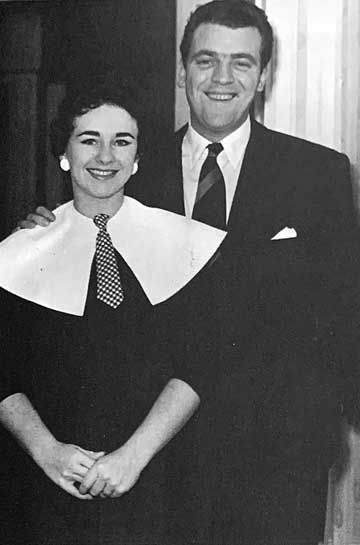
Eamonn married Grainne Bourke in November 1951
It was while presenting Double or Nothing at the Theatre Royal that Eamonn met Joe Loss, who would change the course of his professional career:
"...a dynamic man... suddenly quick-stepped into my life with results which were to be surprising and full of excitement."
Joe, a highly successful bandleader booked for a two-week engagement at the Theatre Royal, liked what Eamonn was doing with Double or Nothing and offered him the opportunity to bring the show to England.
"I thought he was joking. But I said yes, I would like to go. The idea of getting a chance in England with a big name like Joe Loss was far too good to even hesitate about."
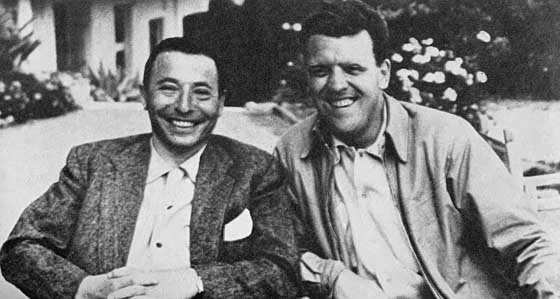
After meeting at Dublin's Theatre Royal, Eamonn and bandleader Joe Loss formed a lifelong friendship
Eamonn, who had previously made several unsuccessful attempts to secure broadcasting work with the BBC in London, now had the chance, through his offer from Joe Loss, to apply to the corporation in person:
"I'd sent countless letters, tapes and discs and got nowhere. Maybe the personal approach might do the trick."
While in London, Eamonn approached the BBC directly, and eventually, an opportunity arose. The Canadian-born broadcaster Stewart MacPherson, one of the most familiar voices on British radio during the Second World War, announced he was leaving the corporation. Eamonn was swift to try the BBC again - pointing out that he could do everything that MacPherson did:
"Back came an answer that nearly knocked me stiff. They had, they said, placed my name on a short list of people who would be auditioned for the chairmanship of Ignorance is Bliss. I can't describe how I felt. I nearly burst."
The audition was successful, so at the age of 27 in 1950, Eamonn Andrews moved to London, secured himself an agent, and began a broadcasting career with the BBC that would last 14 years.
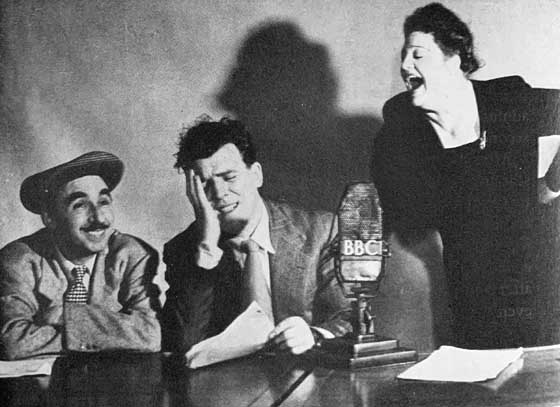
Eamonn Andrews chaired his first edition of Ignorance is Bliss, a BBC radio comedy quiz show, on 27 February 1950
In addition to Ignorance is Bliss, Eamonn worked on other radio programmes, including Sports Report, a Saturday afternoon football results programme, which he joined in December 1950 and would continue contributing to until 1964.
Although confident as a radio broadcaster, the idea of appearing on television had not thrilled him. His first venture into the medium saw him losing his tie while clambering into a boxing ring to conduct a live interview.
However, in the spring of 1951, the BBC commissioned a new television game show from America called What's My Line? in which a celebrity panel tried to guess the occupation of members of the public.
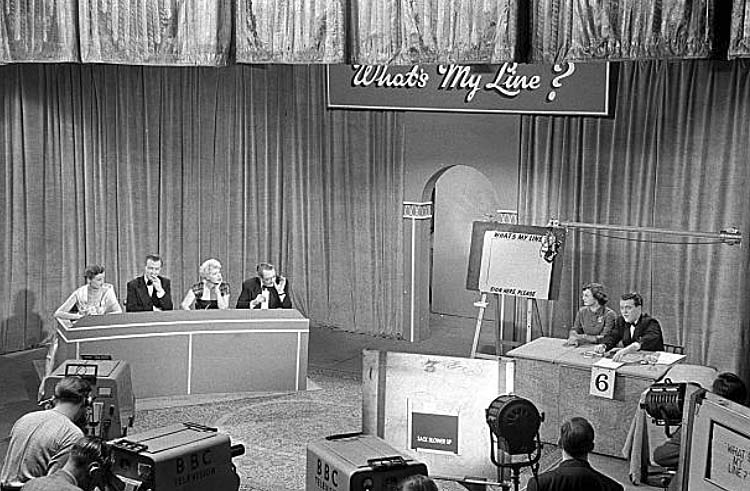
What's My Line? - a panel game show from America, debuted on BBC Television in the summer of 1951 with Eamonn Andrews as the chairman
Eamonn had received high praise for his radio work and was an obvious choice to chair the new show. What's My Line? debuted on BBC Television on 16 July 1951 and became an instant hit.
"I became, almost overnight, a face. I acquired that new, meaningless description for people who can neither sing nor dance nor juggle nor play the harp - a personality. Television personality."
By 1955 the BBC - now well aware of Eamonn's talent and popularity - were on the lookout for a new show for him to front. Ronnie Waldman, the then head of BBC Light Entertainment, had his sights set on creating a British version of a hugely popular American show called This Is Your Life.
Waldman had already lined up Leslie Jackson as the show's producer. Leslie, who produced What's My Line?, had expressed interest in Eamonn as host for the new programme, so Waldman took advantage of Eamonn's assignment as a boxing commentator for the Rocky Marciano/Don Cockell fight in San Francisco and requested that he take a look at the show while he was in America:
"Well I had a look at it, saw an American named Ralph Edwards presenting it, and my first reaction was: This is Television. I immediately cabled Waldman, saying I thought it was a great programme and one that I would very much like to do. Certain changes would have to be made, but I was convinced the show could be a great success in England too."
Worried it wasn't a BBC-style show, corporation executives were initially sceptical about the format and its possible impact on British audiences, but eventually, they were persuaded to commission a monthly series.
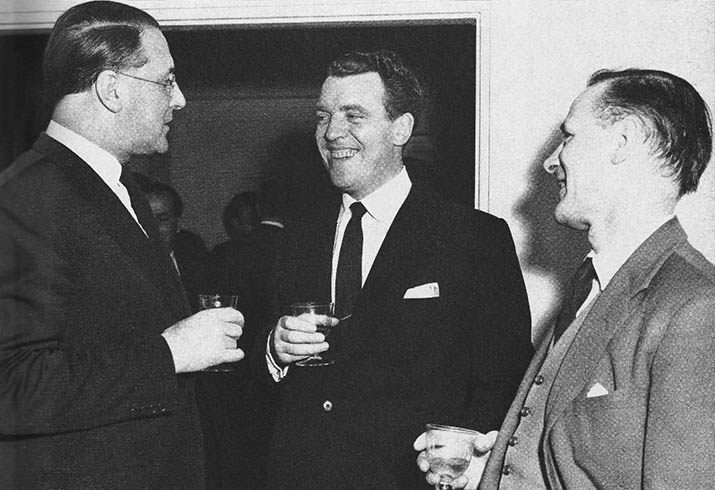
Kenneth Adam (left), Director of Programmes at the BBC with Eamonn and Leslie Jackson (right), the first producer of This Is Your Life
The creator and host of the American version, Ralph Edwards, came to London, along with his producer, Axel Gruenberg, to arrange and present the first British edition. The original choice of subject for the first show was the footballer Stanley Matthews. However, when The Daily Sketch newspaper broke the story before the surprise, plans had to be hastily changed.
Although Eamonn had been part of the initial planning process, unbeknown to him, the production team decided to select him as the first subject whilst tricking him into believing that his old boxing pal Freddie Mills would be Matthew's replacement.
So, on Friday, 29th July 1955, Eamonn Andrews and Freddie Mills took their seats at the BBC Television Theatre in Shepherd's Bush, west London, as Ralph Edwards, on live television, teased the audience about whose life story would be told on Britain's first edition of This Is Your Life.
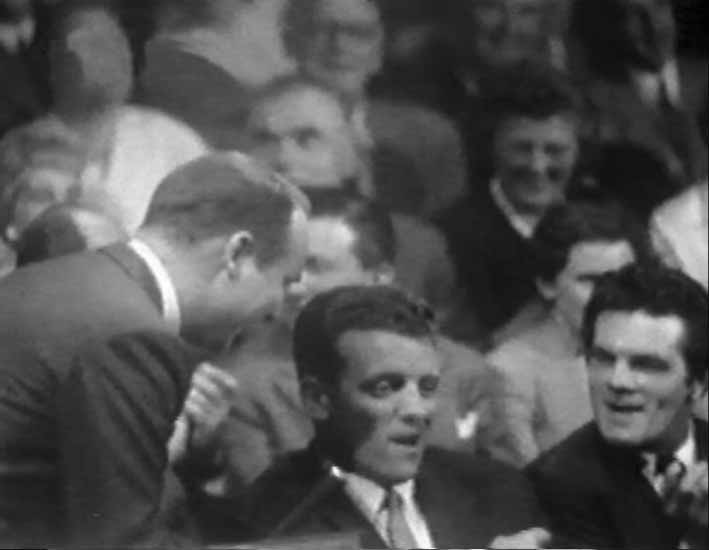
Ralph Edwards presents the first This Is Your Life book on British television to Eamonn Andrews
Ralph Edwards handed Eamonn the This Is Your Life book and asked him to read the cover as Eamonn would subsequently do to many of his future subjects. His reaction on seeing his name printed on the cover was – "This Is Your – oh blimey!"
"My reaction at the moment of impact was that of getting a shock. I felt myself tremble. It is so unbelievable that you are going to be thrown into that spotlight. You don't know what is going to come, and when it begins, the memories keep flooding back."
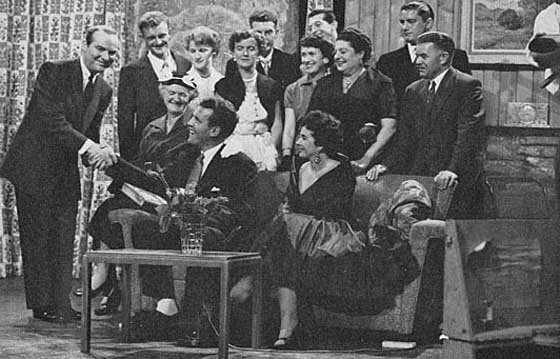
Eamonn Andrews, as a subject of This Is Your Life, received a taste of what his future subjects would experience
"It's like a dream, it goes so fast. I don't think you enjoy it or not enjoy it, while it is happening. I know I was in a daze, and it was all great fun and wonderful, but I enjoyed it even more in retrospect."
The first edition of This Is Your Life was a huge success and received positive responses from critics and the general public. As a consequence of being surprised by Ralph Edwards, Eamonn had received a taste of what his future subjects would experience, and to him, the show's centrepiece would always be the surprise.
This Is Your Life progressed from monthly broadcasts to fortnightly and then weekly. And Eamonn became synonymous with the programme; viewers liked his friendly style, and his professionalism meant he appeared relaxed with people from all backgrounds.

Eamonn presented 255 editions of This Is Your Life for the BBC between 1955 and 1964
He became an essential member of the production team and kept a little black book in which he would write down his suggestions for future subjects.
Defining the ideal subject, Eamonn once commented:
"The basic requirement is a good story, a varied story, and if you can add to that a pleasant, bubbling personality, then you have something else going."
"It has given me the most tense moments I've ever had in broadcasting. It has shown me more than a lifetime of books could, the achievement and the courage and the sparkle all around us every day of our lives. Apart from throwing new light on the famous, it clearly demonstrated that many little people have big, inspiring stories."
Eamonn also presented several other television shows for the BBC, including the children's programmes Playbox and Crackerjack!, which included his own invention: the parlour game 'Double or Drop'.
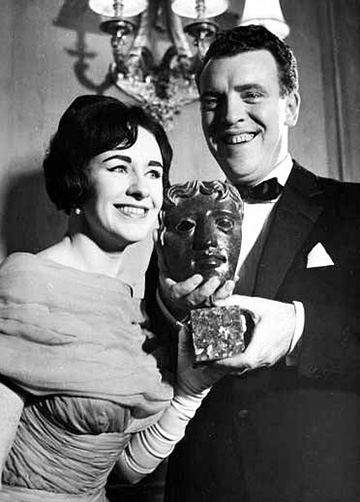
Eamonn was awarded a BAFTA for the 1960 Television Personality of the Year
Throughout this period, Eamonn continued to maintain strong links with Ireland. As Chairman of the Radio Éireann Authority, he oversaw the introduction of a state television service. He compered Telefís Éireann's opening night broadcast on New Year's Eve 1961. And in addition, he established a media production company in Dublin, the Eamonn Andrews Studios, which pioneered the provision of sponsored programmes in Ireland.
The announcement in 1964 that the BBC had cancelled This Is Your Life came as a blow to Eamonn, as it followed the recent news that his other ratings winner, What's My Line?, had also been axed.
However, Eamonn received a lucrative offer from Brian Tesler, Programme Controller at ABC Television, with the opportunity for him to front their new sports programme, World of Sport, as well as his own live weekly chat show, a well-established format in America, but untested on British television.
So negotiations began between Tesler and Eamonn's agent, Teddy Sommerfield:
"The negotiations for my defection were carried out like some Le Carre spy plot. To ensure absolute secrecy, Brian would arrange to meet Teddy and me in a leafy London square and talk through the financial details in the back of a huge black Mercedes with tinted windows. When I shook off the nostalgia and annoyance and the fear of the freelance, I recognised Tesler's offer for what it was: a very exciting and challenging moment in my career."
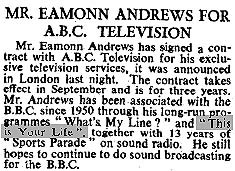
The Times 15 January 1964
Mr Eamonn Andrews has signed a contract with ABC Television for his exclusive television services, it was announced in London last night. The contract takes effect in September and is for three years. Mr Andrews has been associated with the BBC since 1950 through his long-run programmes "What's My Line?" and "This Is Your Life", together with 13 years of "Sports Parade" on sound radio. He still hopes to continue to do sound broadcasting for the BBC.
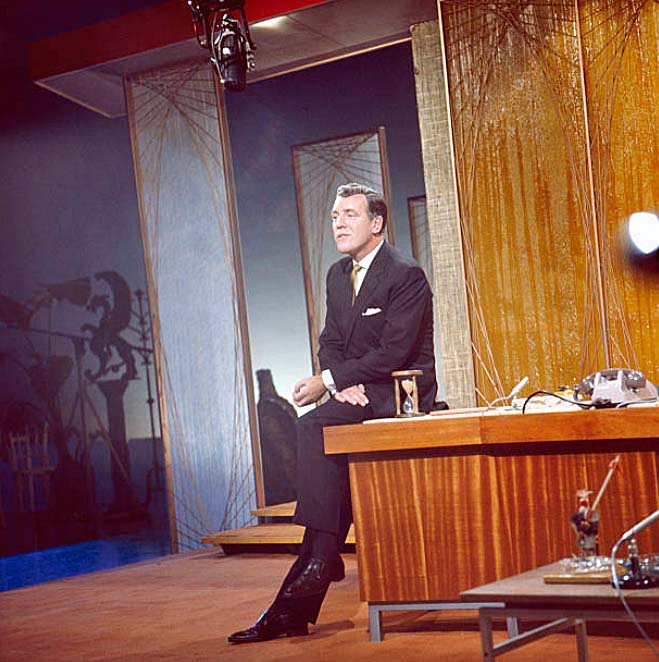
Eamonn's chat show, The Eamonn Andrews Show, launched in October 1964 and quickly became a success, attracting guests as diverse as Noel Coward and The Beatles

Bob Hope and Bing Crosby's second double-act appearance as guests of Eamonn's chat show
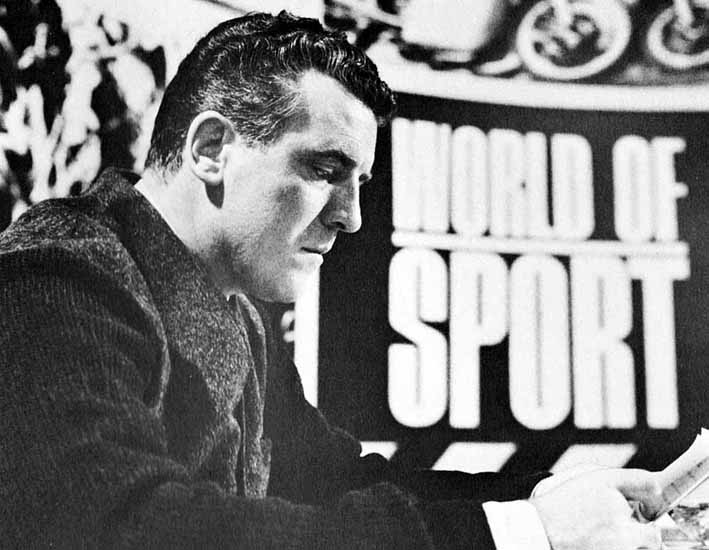
And Eamonn launched World of Sport on the ITV network in January 1965
"The Eamonn Andrews Show often frightened me. Many critics said it frightened them, too. But the fact is it would have run for many years had the ITA not changed the style of contracts so that ABC died. Thames Television was born, and I became a weekday man instead of a weekend one."
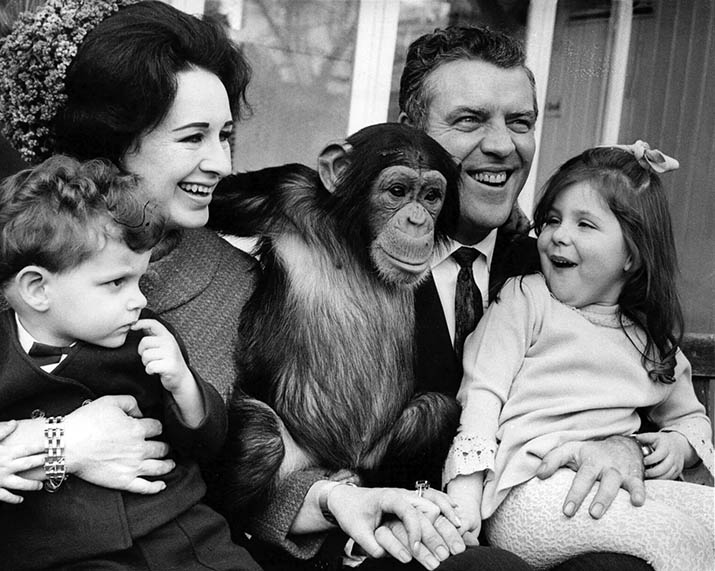
United Press International Photo: 14 April 1967. HAPPY FAMILY: Today was Grainne Andrews' birthday, and husband Eamonn decided to take her and the children to the London Zoo, where they are seen wowing a chimpanzee called Mary. Left to right: son Fergal, Grainne, Mary, Eamonn and daughter Emma. Eamonn is the host of the television programme The Eamonn Andrews Show and World of Sport.
In 1968 the government reviewed the Independent Television Authority's regional franchises. In London, ABC was forced to merge with Rediffusion, resulting in the creation of Thames Television. This new company was now faced with the dilemma of what to do with their poached BBC star – now devoid of his networked chat show.
Eamonn was given the task of fronting Thames Television's new Today programme. Conceived as the jewel in the crown of their local programming, and launched on 30 July 1968, the daily live entertainment and information show aimed to reflect 'what is going on in London'.
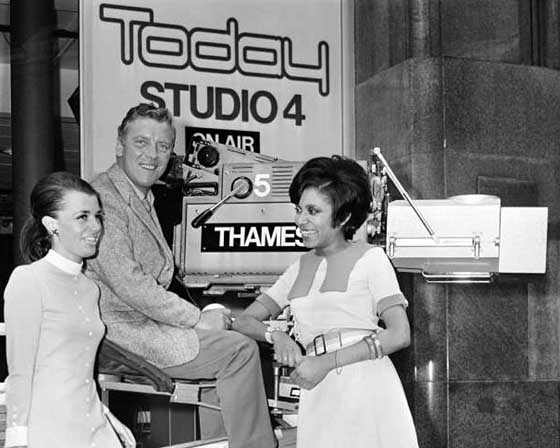
Eamonn Andrews presented Thames Television's Today programme from 1968
However, it wasn't long before Eamonn suggested the idea of reviving This Is Your Life. He felt that the BBC had killed off the show too early and that the format had years of 'life' still in it. Enthused by the prospect of This Is Your Life in colour for the first time, Brian Tesler - now the Head of Light Entertainment at Thames Television - commissioned a 13-part series.
So in November 1969, This Is Your Life was relaunched. The revival was an instant hit for Thames Television, and Eamonn's instincts were proved correct. That first series was extended to 26 editions.
This Is Your Life remained a ratings winner throughout the 1970s and into the following decade. Eamonn was undoubtedly a significant factor in the show's newfound popularity. He was passionately interested in people, and his enthusiasm for the programme was as strong as ever.
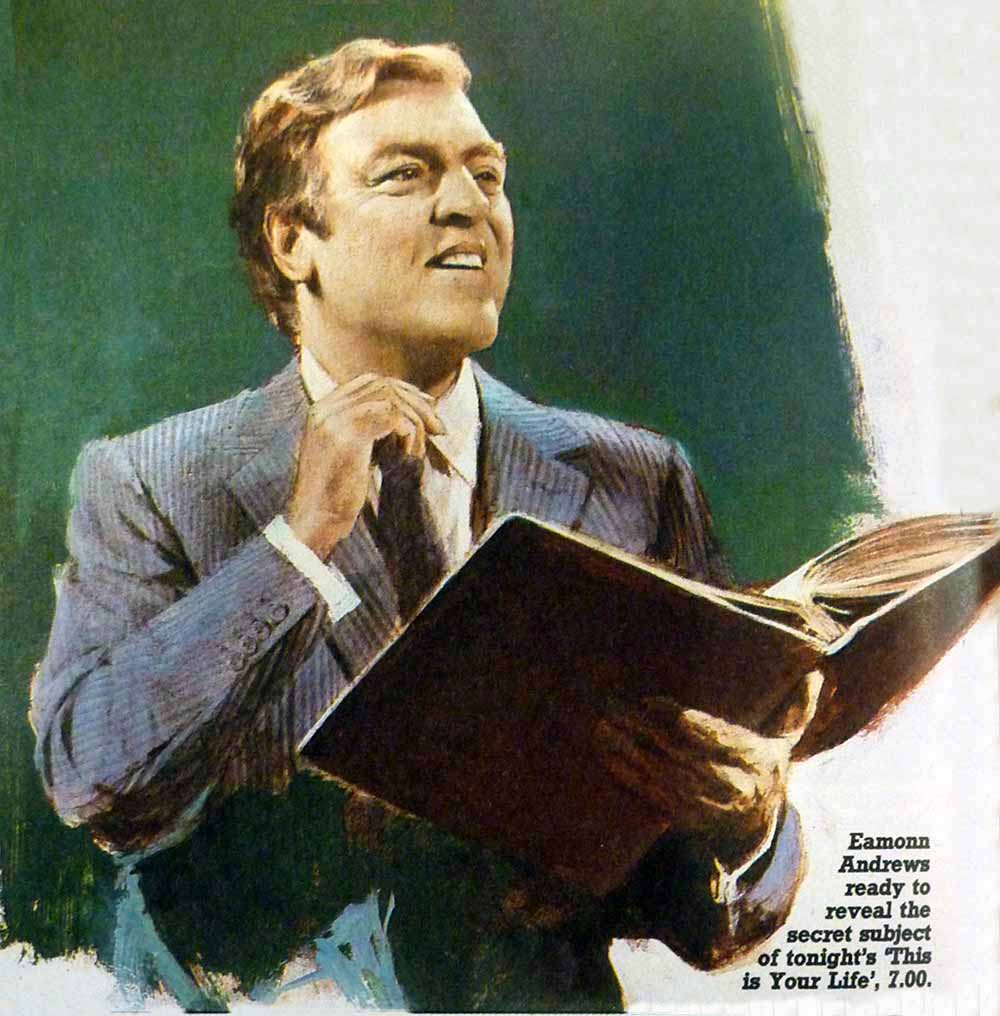
An illustration of Eamonn published in TV Times magazine
As a major part of the show's production team, he was influential in helping to secure such high-rating subjects as Muhammad Ali and Lord Mountbatten. However, his dream to surprise the Queen Mother went unfulfilled!
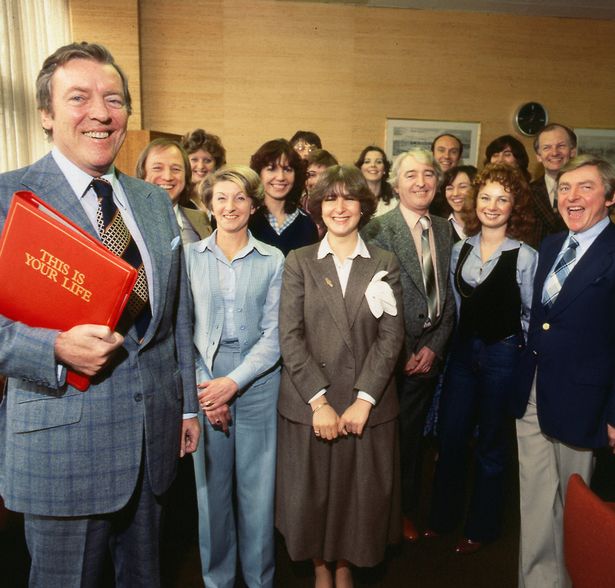
Eamonn Andrews presented 480 editions of This Is Your Life for Thames Television between 1969 and 1987
Eamonn was painstaking in his approach to the show and worked under immense pressure. Absolute integrity and total secrecy were the show's watchwords.
The surprise, or 'pick up' as it became known, was more nerve-racking for Eamonn than he perhaps cared to admit.
"No show is the same. Each one is different because the subject is a different person, so for me, it's a new experience with fresh tensions. I'm never sure that a potential subject will actually agree to accept the red book."
Since 1961 Eamonn and Grainne had been living in a beautiful riverside house in Chiswick, west London, with their three adopted children, Emma, Niamh and Fergal. But in 1970, the family decided to move back to Ireland. They set up a home in Portmarnock, just outside Dublin, from where Eamonn commuted to London for weekly meetings and recordings.
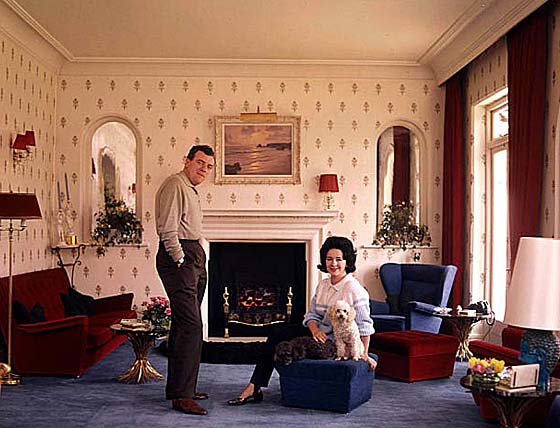
After several years of living in London, Eamonn and his wife Grainne moved back to Ireland
Eamonn became a subject of This Is Your Life for a second time in May 1974 when he was surprised while appearing as a guest on The David Nixon Show. He had agreed to assist with the magic trick of sawing a person in half:
"I was starting to use the saw when David produced the most enormous This Is Your Life book I'd ever seen. I thought it was another joke. I only began to realise it was for real when I spotted our resident This Is Your Life photographer, Stan, in the audience. He's always there to take special shots for the final presentation version of the Big Red Book."
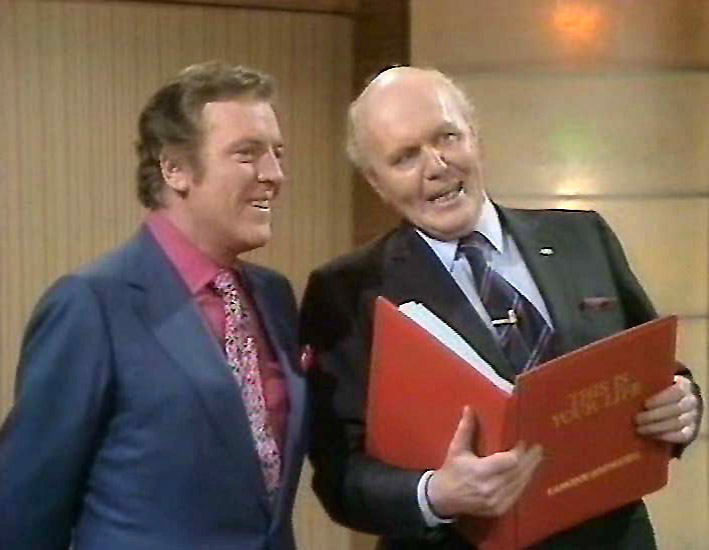
Magician David Nixon took on the hosting duties when the This Is Your Life team surprised Eamonn for a second time in May 1974
His guests on the second tribute included Joe Loss, his former colleagues from Ignorance is Bliss, Crackerjack! and What's My Line? and a live link with Muhammad Ali.
"The moment that touched me most of all was when Grainne came on, kissed me, and I could see, through the affection that I so happily take for granted, a flicker of anxiety, trying to assess whether I was pleased or not that she had decided to go with it. I told her then, and I tell her now that I was mightily pleased."

Eamonn would spend long hours in his home study correcting television scripts and dealing with his extensive correspondence
In addition to This Is Your Life, Eamonn presented Thames Television's London news magazine programme Today, four nights a week until 1977. Then in 1984, and now in his 60s, Eamonn agreed to host his other former BBC programme, What's My Line? when the panel show was revived by Thames Television.
A self-confessed workaholic, Eamonn showed no signs of slowing down, despite a doctor's warning after contracting bronchitis. In ailing health, he continued working to his limit, fulfilling a long-held desire to record editions of This Is Your Life in Hollywood in 1986, when the team flew out to Los Angeles to surprise Dudley Moore and Christopher Cazenove.
Following several bouts of illness, exacerbated by the demanding schedule and anxiety over some troubled business interests in Dublin, friends, colleagues, and viewers became increasingly concerned about him.
As the 28th series of This Is Your Life began, it was obvious that Eamonn was deteriorating physically. Only at Grainne's behest did he agree to postpone the planned recording of a particular show and attend London's Cromwell Hospital for urgent tests.
Eamonn died peacefully in his sleep in hospital in the early hours of 5 November 1987.
That evening ITV broadcast a special tribute programme hosted by Terry Wogan.
With the approval of the Andrews family, the three editions of This Is Your Life which Eamonn had recorded before his death, were broadcast early in 1988. These were followed by the repeat showing of five editions from previous series, specially chosen by the family.
Press speculation about the future of This Is Your Life began almost immediately. The television industry and viewers believed that no one could replace Eamonn and that the show would die with him. Time proved otherwise.
There is no denying how seriously he took his work and how passionately he believed in This Is Your Life:
"All of us have, I'm sure, an in-built desire for surprises from the first Christmas stocking we ever hung. There is hardly a person in these islands who, at one time or another, hasn't crept down to the end of the bed on Christmas morning and experienced the thrilled surprise of delving into the Christmas stocking.
I'm sure that desire for surprise stays with all of us, and that is why, on This Is Your Life, we keep the contents of the stocking a surprise for the guest of honour. We do it not to shock, not to pry, but to give them that moment of joy... to excite the reaction: 'What, it's for ME, this gift?'
I think viewers share this. We continue the theme of surprise by picking out of the stocking, out of the parcel, more and more gifts... And as we try to enchant our guests, we hope, at the same time, to tell viewers a story worth telling."
